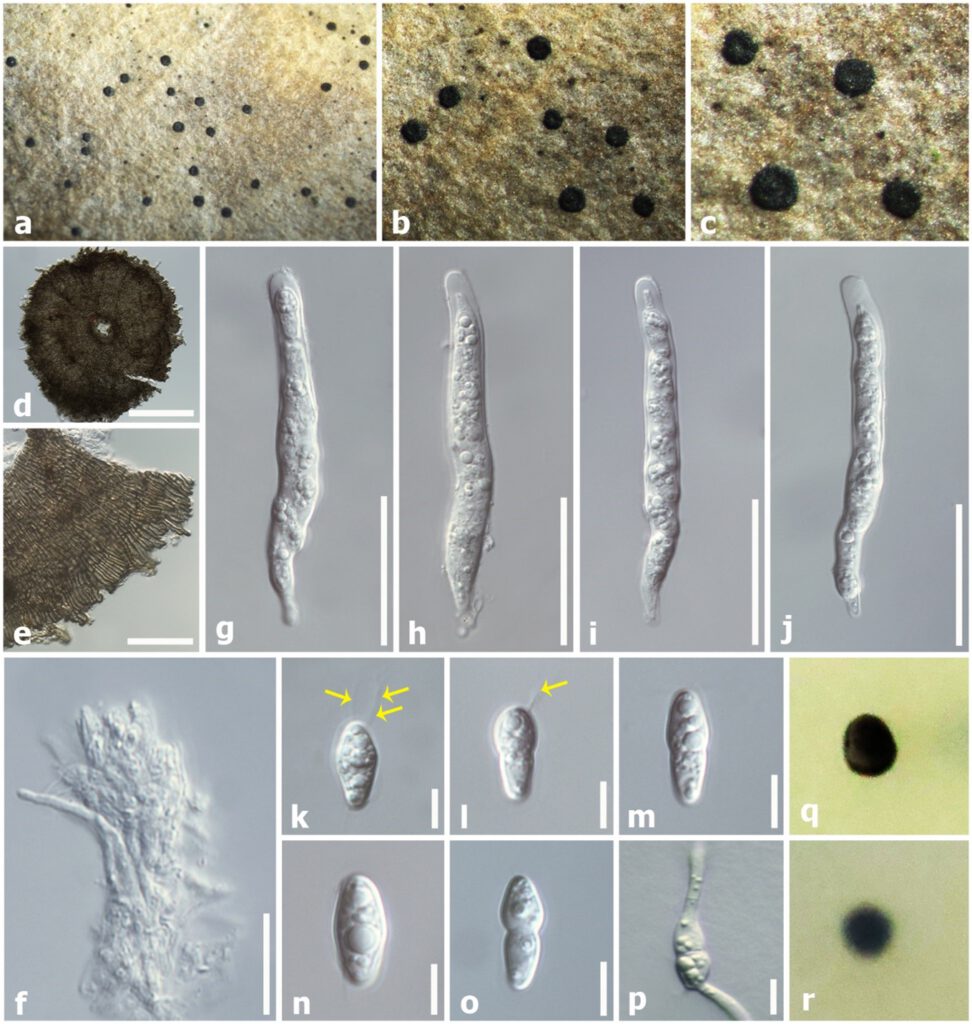Tumidispora thailandica Tennakoon, S. Hongsanan & S. Lumyong sp. nov.
MycoBank number: MB; Index Fungorum number: IF; Facesoffungi number: FoF 11796; FIGURE 3
Etymology: — The specific epithet “thailandica” refer to the country in which the fungus was first collected
Holotype: — MFLU 19-2771
Epiphytic on the upper surface of dead leaves of Dimocarpus longan Lour. (Sapindaceae), appearing as small black dots. Superficial hyphae absent. Sexual morph: Thyriothecia 200–260 × 210–280 μm ( = 230 × 240 µm, n = 10), solitary, superficial, scattered, flattened, circular, brown to black, poorly developed basal layer, easily be removed from the substrate, with prominent, darker, central ostiole, darker around the ostiole, dark brown towards the outer lighter rim, irregularly rounded at the margin. Upper wall comprising brown cells of textura angularis, radiating in slightly irregular, but parallel lines from center to the outer rim. Hamathecium comprising 2 μm wide, branched pseudoparaphyses, asci inclined towards the central ostiole. Asci 40–46 × 5–7 μm ( = 45 × 6 µm, n = 20), 8-spored, bitunicate, fissitunicate, cylindrical to cylindric-clavate, short pedicellate, apically rounded, with an ocular chamber. Ascospores 9–11 × 3–4 μm ( = 10.5 × 3.5 µm, n = 10), 1–2-seriate, hyaline, fusiform, rounded ends, 1-septate, constricted at the septum, apical cell swollen and wider, basal cell sub-conical, two appendages start from upper cell, smooth-walled with guttules. Asexual morph: Undetermined.
Culture characteristics: — Colonies on PDA, 18–22 mm diam. after 4 weeks at 25 °C, colonies from above: medium dense, circular, raised, surface smooth, entire margin, light green at margin, dark grey to brown at centre; reverse: light brown to light green at margin, dark grey to black at centre. Mycelium dark grey to black with tufting.
Material examined: — Thailand, Chiang Mai, dead leaves of Dimocarpus longan (Sapindaceae), 25 April 2018, D. S. Tennakoon, DHAY021 (MFLU 19-2771, holotype); ex-type living culture, NCYUCC 19-0254. ibid. 28 April 2018, DHAY021B (NCYU 19-0090, Paratype); ex-paratype living culture, NCYUCC 19-0345.
GenBank numbers: — LSU: XXXX; ITS: XXXX.
Notes: — The morphological characteristics of our collection (MFLU 19-2771 and NCYU 19-0090) tally well with the generic concept of Tumidispora, in having flattened, circular, brown to black thyriothecia, cylindrical to cylindric-clavate, short pedicellate asci and 1-septate, hyaline ascospores with a swollen apical cell (Ariyawansa et al. 2015). However, our collection differs from the type (Tumidispora shoreae) in having shorter asci (40–46 × 5–7 μm vs 53–55×7–8 μm) and ascospores (9–11 × 3–4 μm vs 14–15 × 4–5 μm). In addition, our collection ascospores are distinctly fusiform with rounded ends and consist two appendages in the upper cell, whereas Tumidispora shoreae has narrowly fusiform ascospores with sub-papillate ends and lacking of appendages (Ariyawansa et al. 2015). Phylogeny also indicates that our collection (MFLU 19-2771 and NCYU 19-0090) forms an independent lineage sister to Tumidispora shoreae isolates (MFLUCC 12-0409 and MFLUCC 14-0574) with strong statistical support (100% ML, 100% MP, 1.00 BYPP, FIGURE 1). Therefore, based on both morphology and phylogeny evidence, we introduce our collection (MFLU 19-2771 and NCYU 19-0090) as a new species, Tumidispora thailandica from dead leaves of Dimocarpus longan in Thailand.

FIGURE 3 Tumidispora thailandica (MFLU 19-2771, holotype). a, b Thyriothecia on surface of leaf. c Close-up of Thyriothecia. d Thyriothecium when, viewed in squash mount. e Upper wall of thyriothecium when viewed in squash mount. f Pseudoparaphyses. g–j Asci. k–o Ascospores (yellow arrows show appendages in upper cells). p A germinating ascospore. q Colony from above (on PDA). r Colony from below (on PDA). Scale bars: d = 100 μm, e = 50 μm, f–j = 20 μm, k–p = 5 μm.
